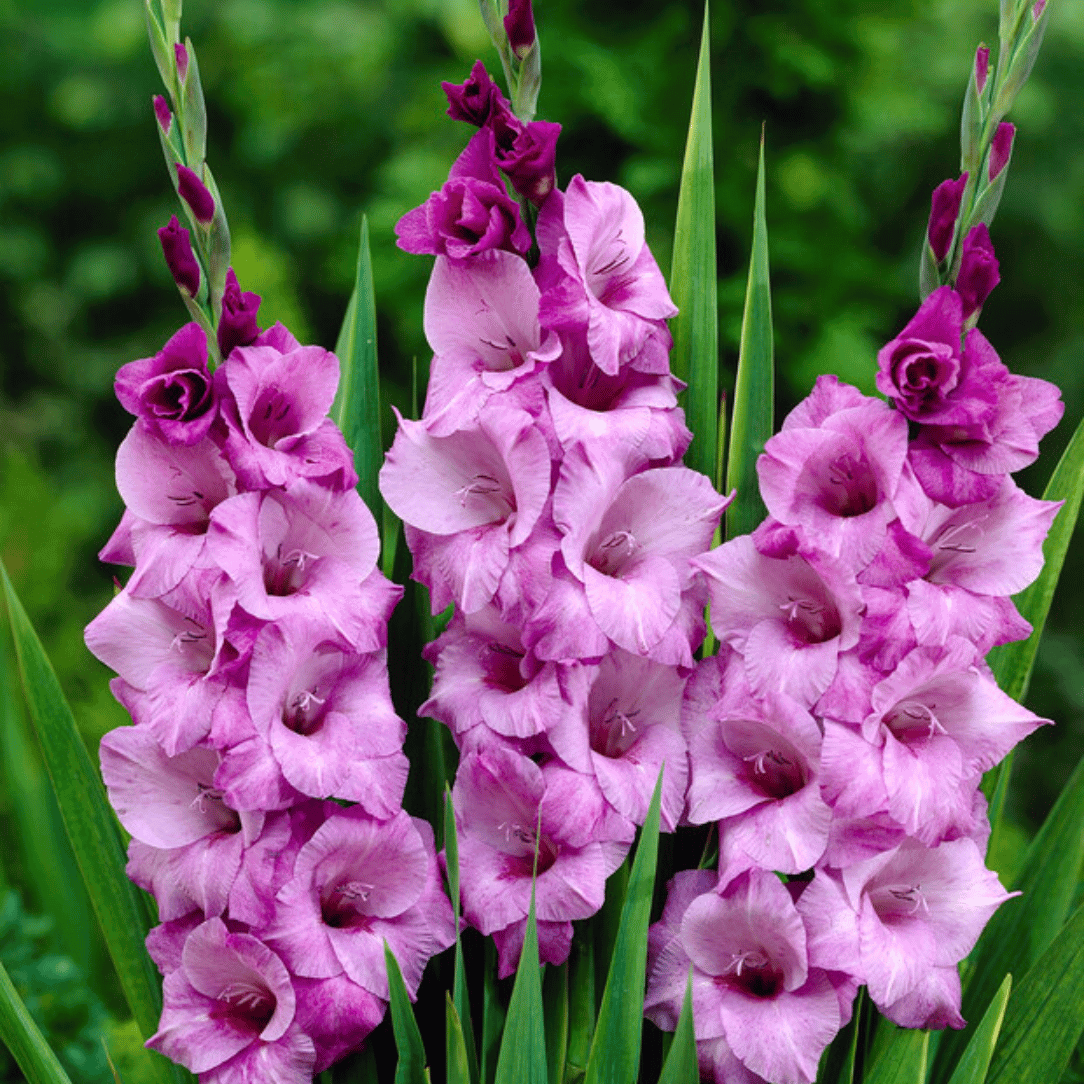Few plants can match the dramatic flair of gladiolus. With tall, upright flower spikes and brilliant blooms that seem to defy gravity, gladiolus is a natural focal point in borders and cutting gardens. It evokes elegance, precision, and a sense of celebration with its structured form and vivid hues.
Often associated with remembrance and strength, gladiolus stands tall not only in stature but in garden symbolism. With thoughtful planting and care, these majestic spires will reward you with weeks of vibrant display.

Portrait of the Gladiolus
Gladiolus, often called “sword lily” due to its blade-shaped leaves, is a genus in the Iridaceae family. Native to South Africa and the Mediterranean, it’s loved for its eye-catching floral spikes and ease of cultivation.
- Type: Tender perennial grown from corms
- Family: Iridaceae
- Common Names: Gladiolus, Sword Lily
Foliage and Form
Gladiolus grows upright with sword-like leaves that form a fan shape at the base. Its foliage is linear, strappy, and vertical, offering a structural element even before blooming.
- Height: 60–150 cm (2–5 ft)
- Spread: 20–30 cm (8–12 in)
- Growth Habit: Erect, upright spire
Blooms and Fragrance
The floral show begins in summer. Flower spikes can bear up to 20 trumpet-shaped blossoms, arranged vertically and opening sequentially from bottom to top.
- Bloom Time: Mid to late summer
- Color: Wide range—red, pink, yellow, purple, white, and multicolor
- Fragrance: Mild to sweet, varies by cultivar
The Right Time to Plant, Prune, and Enjoy Gladiolus
| Month | Planting | Flowering | Pruning |
|---|---|---|---|
| January | ❌ | ❌ | ❌ |
| February | ❌ | ❌ | ❌ |
| March | ✅ In warm climates | ❌ | ❌ |
| April | ✅ Main planting time | ❌ | ❌ |
| May | ✅ Successive plantings | ❌ | ❌ |
| June | ✅ Last plantings | ✅ Early blooms start | ✅ Remove fading blooms |
| July | ❌ | ✅ Full bloom | ✅ Deadhead spent flowers |
| August | ❌ | ✅ Continued blooming | ✅ Cut flower spikes after bloom |
| September | ❌ | ✅ Late bloom (if planted late) | ✅ Foliage trimming after dieback |
| October | ❌ | ❌ | ✅ Dig up and store corms (zones <8) |
| November | ❌ | ❌ | ✅ Clean and store dry corms |
| December | ❌ | ❌ | ❌ |
✅ = Recommended ❌ = Not advised
Watering, Sunlight, and Environment for Gladiolus
Watering
Gladiolus needs consistent moisture as it grows and blooms. Avoid letting the soil dry out entirely during flowering.
- When to Water: Weekly, more in dry periods
- How Much: 1 inch per week
- Watch out for: Waterlogging near the corms
Sunlight
Gladiolus demands full sun to perform well. Shade leads to floppy stems and fewer blooms.
- Ideal Exposure: 6–8 hours of direct sunlight
- Shady Sites: Weak growth and reduced flowering
Indoor vs Outdoor
This is a true outdoor plant, best grown in beds, borders, or cutting gardens. It does not adapt well to indoor cultivation.
- Best Location: Garden beds, flower borders, cutting gardens
- Avoid: Indoor pots or low-light spaces
Temperature
Gladiolus is sensitive to frost and should be planted only after the danger has passed. In cold climates, corms must be dug and stored indoors over winter.
- Optimal Range: 15–25°C (59–77°F)
- Hardiness Zones: USDA zones 8–11 (as perennial); below zone 8 as annual
- Protection Tip: Mulch in colder areas or lift corms in fall
Ideal Soil Conditions for Growing Gladiolus
| Soil Feature | Optimal Condition | Why It Matters |
|---|---|---|
| Soil Type | Loamy, sandy | Provides good drainage and support |
| Texture | Light, crumbly | Encourages root development |
| Drainage | Well-drained | Prevents corm rot |
| Moisture | Moist, not soggy | Supports stem and flower development |
| Soil pH | Slightly acidic to neutral (6.0–7.0) | Optimizes nutrient uptake |
| Fertility | Moderate to rich | Encourages healthy flowering |
Common Problems & Solutions
| Issue 🐾 | Symptoms 🔍 | Solutions 🛠️ |
|---|---|---|
| Floppy Stems 🌾 | Leaning or bent flower spikes | Stake plants; ensure full sun |
| Rotting Corms 💧 | Mushy, foul-smelling corms | Improve drainage, rotate crops |
| Thrips 🐛 | Streaked petals, discolored flowers | Use insecticidal soap or neem oil |
| Poor Blooming 🌱 | Few or no flowers | Fertilize properly and plant in full sun |
| Yellow Leaves 🍂 | Nutrient deficiency or overwatering | Balance watering and apply composted mulch |
Gladiolus brings sophistication and drama to summer gardens. Perfect for bouquets and bold garden statements, these upright spires are a tribute to the beauty of structure and form. Whether you plant them en masse or dot them along borders, gladiolus will reward you with vibrant, vertical elegance—and a season of spectacular blooms.